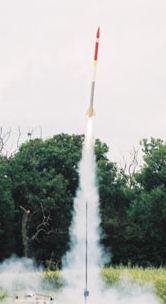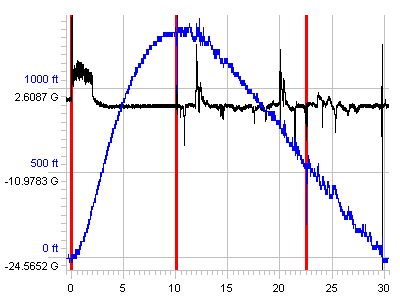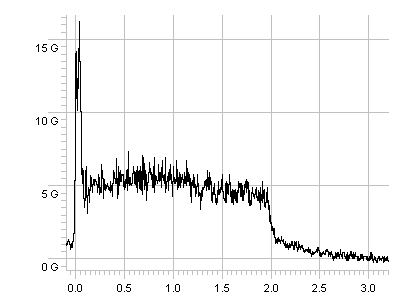R-DAS FLIGHT #14 DETAILS
Flight #: 14
Date: 7th of July, 2002
Venue: EARS, Elsworth, Cambridgeshire
R-DAS Type: R-DAS Compact
R-DAS firmware: 3.2
R-DAS Recorded Altitude: 1366 feet (414 metres)
Apogee - Charge Firing Delta-t: 0 seconds
Apogee - Charge Firing Delta-h: 0 feet (0 metres)
Descent Rate at Apogee Deployment: 0 feet per second (7 metres per second)
R-DAS Flight Mode: Apogee & Main Ejection (breakwire launch detection & smart recovery)
Total Time of Flight: 30 seconds
Apogee - Charge Firing h Variance: 0%
Launch Vehicle Diameter: 2.6 inches
Launch Vehicle Length: 6 feet
Launch Vehicle Propulsion: Hypertek I-225 Hybrid
330/54-125-JFX (0.125 injector orifice)
Fins: 3 clipped swept deltas (Aerofoiled)
Launch System: Rail Launch
Finish: Semi-painted
Ejection Method: Electronic Deployment using apogee charge in SafeEject canister, then main charge in SafeEject canister
Ejection Ignition Type: Daveyfire igniters (electric matches)
Launch Vehicle Mass: 2.5 kg (vehicle with hybrid motor but no oxidiser loaded)
Total Propellant Mass: 298 grams
Total Loaded Motor Mass: 1067 grams
Total Impulse: 524 Newton seconds
Optimum Theoretical Burn Time: 2.40 seconds
Actual Useable Burn Time: 2.25 seconds
|

|
 |
| Comments The fourth flight of the Hephaestus rocket (with sections of the airframe actually painted for a change), launched on the Hypertek I-225 hybrid rocket motor (using a 330cc oxidiser tank and a HyFX fuel grain). The rocket weathercocked less than on its previous flight, with the Compact R-DAS firing the SafeEject fitted ejection charge, separating the motor section and upper section for tumble recovery down to main deployment. The nosecone caught on main charge ejection, preventing the main chute from deploying, however when the rocket was found, the only damage was a 6 inch long cracked section of the drogue bay airframe - an easy repair job. The rocket used a much louder beeper this time, and was easily located thanks to an excellent bearing taken at its point of landing by Roy Trzeciak-Hicks of EARS.
The R-DAS used breakwire launch triggering with smart recovery. This option was again chosen because the oscillation in Hypertek motor combustion has been known to result in irregular launch triggering of the R-DAS. The breakwire and smart recovery option worked perfectly, and both ejection channels fired on cue, but with the nsecone getting jammed and preventing main chute deployment. A breakwire from Airborne Engineering Limited was fitted, and 2 sounders were also carried on the flight, along with a 433 MHz RF tracking beacon.
| |
 | | Thrust Section of Flight | |
|
 |
|
Sat, Jan 3, 2026, 21:33 GMT
(15)  7:30 7:30  16:05 16:05  51
% 51
% |
|
home - space - research - links - contact me - colophon
Richard Osborne - 1995-2006 |
|